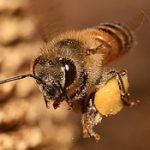Honey bees (or honeybees) are a subset of bees, primarily distinguished by the production and storage of honey and the construction of perennial, colonial nests out of wax. Honey bees are the only extant members of the tribe Apini, all in the genus Apis. Currently, there are only seven recognized species of honey bee with a total of 44 subspecies (Engel, 1999) though historically, anywhere from six to eleven species have been recognized. Honey bees represent only a small fraction of the approximately 20,000 known species of bees. Some other types of related bees produce and store honey, but only members of the genus Apis are true honey bees.
Honey bees as a group appear to have their center of origin in South and Southeast Asia (including the Philippines), as all but one of the extant species are native to that region, notably the most plesiomorphic living species (Apis florea and A. andreniformis). The first Apis bees appear in the fossil record at the Eocene-Oligocene boundary, in European deposits. The origin of these prehistoric honey bees does not necessarily indicate that Europe is where the genus originated, only that it occurred there at that time. There are few known fossil deposits in the suspected region of honey bee origin, and fewer still have been thoroughly studied. There is only one fossil species documented from the New World, Apis nearctica, known from a single 14-million-year old specimen from Nevada.

